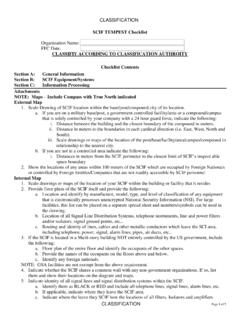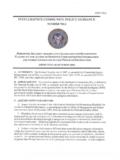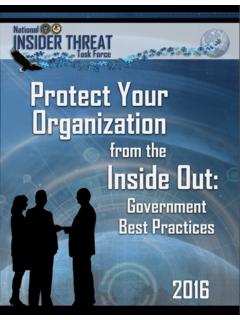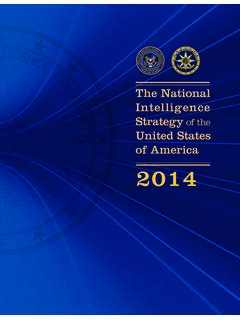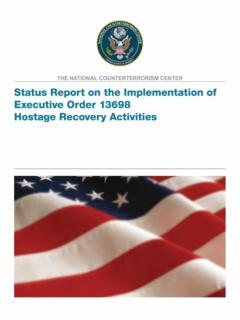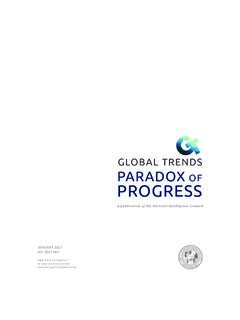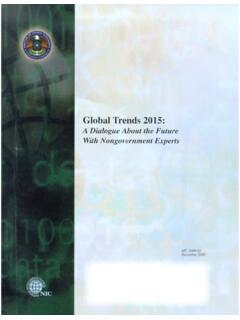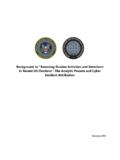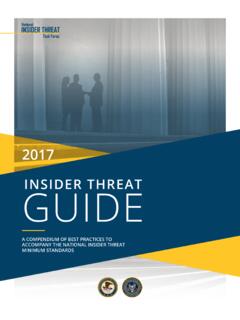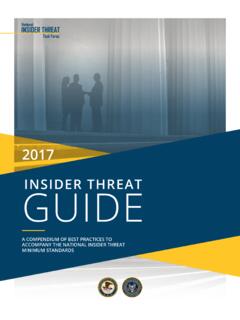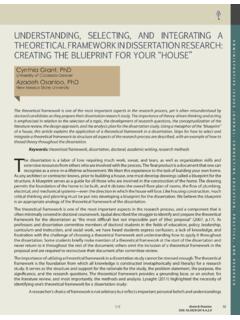Transcription of Protect Your Organization from the Foreign Intelligence Threat
1 NAT I O NA L C O U N T E R I N T E L L I G E N C E A N D S E C U R I T Y C E N T E R. LEADING EFFORTS TO Protect THE NATION AGAINST. Intelligence AND SECURITY THREATS. Protect Your Organization from the Foreign Intelligence Threat Introduction by Michael J. Orlando, Senior Official Performing the Duties of the Director of NCSC. T oday the global Threat environment is more diverse and dynamic than ever. As spelled out in the latest Annual Threat Assessment of the Intelligence community (IC), a growing number of state actors and non-state actors are targeting the United States.
2 They are no longer just interested in obtaining classified secrets but also are collecting information from almost all Government agencies and virtually every sector of the economy. Personal data, trade secrets, intellectual property, technology, and research and development are all being targeted by adversaries who have the capabilities, patience, and resources to get them. To achieve their objectives, Foreign adversaries are employing a range of illegal techniques, including insider threats, cyber penetrations, supply chain attacks, and blended operations that combine some or all these methods.
3 They are also using a variety of legal and quasi-legal methods, including mergers and acquisitions, investments, joint ventures, partnerships, and talent recruitment programs to acquire technology and innovation. Ultimately, they seek to degrade our economic power and national security, compromise our critical infrastructure, and undermine our democratic institutions and ideals. This new form of conflict is not fought on a Foreign battlefield, but in our power grids, our computer networks, our laboratories and research facilities, our financial institutions, our healthcare providers, and our federal, state, local, and tribal governments.
4 This battle will not be won by weapons and warriors, but by public and private sector partnerships and through American dedication and diligence. This document is designed to provide public and private-sector organizations with an overview of counterintelligence (CI) and security best practices to help guard against Foreign Intelligence threats. The document includes links to risk mitigation materials that can help organizations improve their physical security, personnel security, operations security, cybersecurity, defensive CI, insider Threat mitigation, and supply chain risk management.
5 Intelligence community Campus, Bethesda, Maryland Page 1. NAT I O NA L C O U N T E R I N T E L L I G E N C E A N D S E C U R I T Y C E N T E R. LEADING EFFORTS TO Protect THE NATION AGAINST. Intelligence AND SECURITY THREATS. What is the Threat from Foreign Intelligence Entities? The term Foreign Intelligence entity refers to a known or suspected Foreign state or non-state Organization or person Their Methods that conducts Intelligence activities to acquire informa- tion, block or impair Intelligence collection, influence Elicitation: The use of conversation to extract information, either in person, by email, on the policy, or disrupt systems and programs.
6 This term phone, or through social media. includes Foreign Intelligence services defined as state Intelligence services and also can pertain to international Social Engineering: The impersonation of others to seem legitimate and surreptitiously acquire terrorists, transnational criminal organizations, Foreign passwords or other key data. cyber actors, or Foreign corporations or Economic Espionage: The theft or misappropriation Regional adversaries and ideologically motivated entities, of a trade secret with the intent or knowledge that the offense will benefit a Foreign entity.
7 Such as hackers and public disclosure organizations, also pose a growing Threat to the United States. These actors Human Targeting: The targeting of individuals with have been able to advance their goals through the prolifer- access to sensitive information, who, for example, ation of more advanced and commercially available cyber might unexpectedly meet someone who shares their interests or seeks an ongoing relationship. and surveillance technologies. Cyber/Technical: Digital technologies used to The National CI Strategy of the United States of America compromise or acquire information stored or 2020-2022 spells out three principal trends that characterize transmitted electronically.
8 The current and emerging Threat environment: The number of Threat actors targeting the United States is growing These actors have an increasingly sophisticated set of Intelligence capabilities at their disposal and they are employing them in new ways to target the United States Threat actors are using these capabilities against an expanded set of targets and vulnerabilities In short, today's Threat environment no longer is characterized by the traditional spy-versus-spy game played by competing state Intelligence services. It has evolved to include a broader range of actors using a wider variety of tools, both licit and illicit, to collect against a broader set of targets.
9 These Threat actors are employing innovative combinations of traditional spying, economic espionage, and supply chain and cyber operations to acquire sensitive information, research, and technology from the economy as well as to gain access to our critical infrastructure. Threat actors also are conducing malicious influence campaigns that employ cyber operations, media manipulation, and political subversion to sow divisions in our society, undermine confidence in our democratic institutions, and weaken our alliances. 1. NCSC, National Threat Identification and Prioritization Assessment, 2018.
10 Page 2. NAT I O NA L C O U N T E R I N T E L L I G E N C E A N D S E C U R I T Y C E N T E R. LEADING EFFORTS TO Protect THE NATION AGAINST. Intelligence AND SECURITY THREATS. How Do We Counter the Threat ? The National CI Strategy of the United States of America The United States is entering into 2020-2022 spells out five strategic objectives for the Government in countering these threats. In addition to a period of intensifying strategic addressing its core CI mission of protecting classified competition with several rivals, most information and facilities, the strategy dictates that notably Russia and China.
